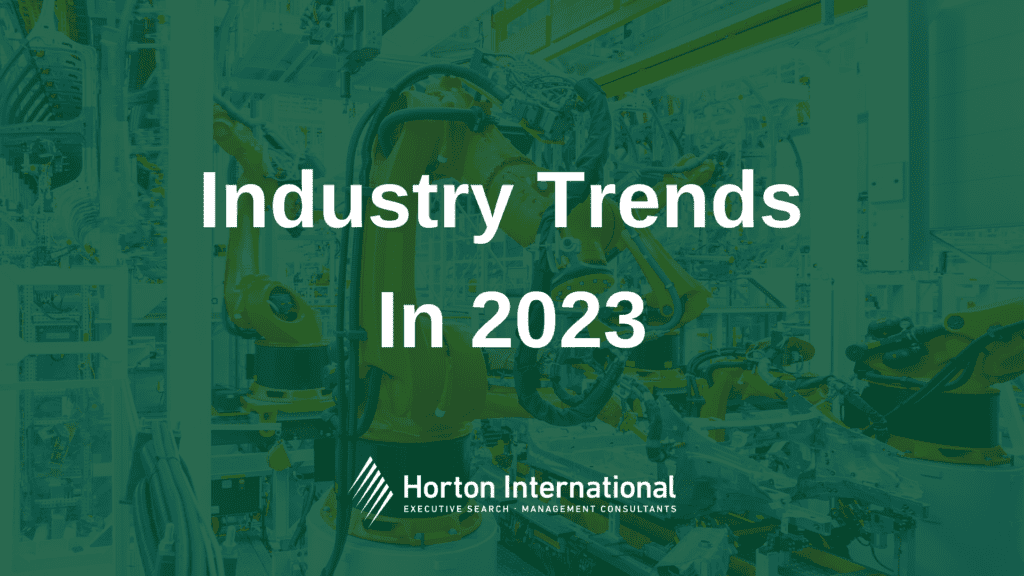Digital transformation has been shaping the manufacturing industry for some years. Industry 4.0 was launched in 2015 as a new industrial revolution in which artificial intelligence, advanced robotics, bio-engineering, IoT, cloud computing and other advanced technologies each play a part in creating a new way of doing things. However, according to Deloitte, by 2018, most manufacturing businesses were ill-prepared to take it on board, and Covid-19 further dampened enthusiasm. A further note of pessimism is the threat of global post-pandemic recession.
Despite these headwinds, the manufacturing industry remains optimistic regarding the industry’s future. There is a desperate need within manufacturing to hire and retain talent that will drive recovery and renewal. Indeed, those that survive and thrive will reap the rewards as the economic climate eases and moves onward into sustained future growth. While there will be both winners and losers, the following industry trends seem set to dominate growth throughout and beyond 2023. We will examine the following trends:
- The need for talent
- Current technology trends
- Supply chain considerations
- Sustainability
Talent
There is a desperate talent shortage throughout the industry, and attracting and retaining top talent is highly competitive and demanding. The manufacturing industry will have 2.1 million unfilled jobs by 2030 equating to financial losses of around $1 trillion a year. Already 85% of engineering and manufacturing businesses in the UK report huge skills shortages which are holding them back.
This talent shortage has been described as a perfect storm. Some reasons include older generations leaving the workforce, often prematurely; the younger generation still lacking the relevant experience to fill the vacancies left behind; and the evolving technologies of Industry 4.0 changing the traditional workplace and demanding new and scarce skills and talents. In addition, worker life choices such as improved work-life balance and higher pay levels play a part.
However, in manufacturing, the shortfall is uneven across states. While there is a deficit of top-level workers in Europe, Japan and the United States, there is a surplus in China and Russia. The most significant skill shortages in Europe will be felt in the UK and Germany.
The shortage will likely boost the trend of using automation to replace the jobs of lower-skilled workers, though this will also increase the demand for highly skilled creative people.
Talent pipeline
In response to these looming talent shortages, companies are creating talent pipelines by hiring future workers fresh out of school and college. These recruits are less costly to hire and can also be trained in ways more appropriate to the company’s ethos and culture. Constant training is likely to be crucial and focus on the ever-changing future of work. The olden days when workers were trained and then worked yet failed to keep up with the changing technology environment, thus becoming surplus to needs, are hopefully banished.
To remain a credible talent, workers must stay continually updated with the individual taking responsibility to ensure this happens. New ways of working are likely to emerge. Labour markets will become more fluid, recruiting staff for specific projects rather than creating a large permanent workforce.
Technology
Throughout 2023 and into the foreseeable future, we can expect more of the same technology trends we have seen over recent yours. These include the continuing advance of artificial intelligence as it takes on an increasing role, cloud computing, 3D printing, edge computing, cobots, and more. While the fully integrated smart factory remains a step too far for most organisations, we will see further development and integration across the manufacturing sector. Drilling a little deeper:
Artificial intelligence
Artificial intelligence (AI) and its partner, machine learning (ML), are transforming the industry. Its benefits include improved quality, reduced operational costs, rapid decision-making, predictive maintenance, enhanced design methods, increased human safety, and always-on manufacturing.
Cloud computing
Cloud computing has been transformational across multiple industry sectors as businesses discover the benefits of removing the need to invest in expensive IT infrastructures and staff. Using cloud computing as-a-service is highly cost-effective and brings many additional benefits that will drive demand through 2023. Its benefits include increased security and resilience, the potential to leverage AI and ML cloud services, creating no-code and low-code applications and websites, and multi-cloud and hybrid cloud solutions for increased agility and scalability.
Edge computing
Processing large volumes of data in real-time at the point of use rather than utilising network resources has many potential advantages, such as real-time analytics, reduced latency, and faster processes. As data volumes continue to explode, the demand for edge computing will similarly expand. Technology is also advancing in the automotive industry, where edge computing is seen as the way forward to develop safe autonomous vehicles.
3D Printing
3D printing and related additive manufacturing methods are revolutionising how items are manufactured. The market is predicted to triple, reaching $44.5 billion by 2026, as the benefits of manufacturing parts locally and on-demand are realised. Currently, 3D printing is used mainly for prototyping and product development; the ongoing trend is for it to take an increasing role in the production of jigs and fixtures along with higher volume applications. The technology is also making inroads into health and dental services.
Cobots
Cobots, or collaborative robots, are becoming increasingly mainstream. Such devices can work side-by-side with human beings, thus requiring far less real estate than conventional industrial robots. As a result, they can be used for many different tasks across various industries. While their primary use has been in the automotive industry, they are now being used increasingly in the food and beverage industry, the electronics industry, healthcare, and hospitality. As a result, the cobot market is anticipated to increase three-fold by 2026, with 50% of the world’s units being shipped from China.
Supply chain
Keeping supply chains running smoothly has proven highly challenging over recent times, yet doing so is critical for many businesses. The current focus of supply chain management is supply chain improvement by incorporating technologies such as robotics, IoT, and blockchain. Supply chain trends include:
- The creation of circular supply chains that rely on recycling used products, breaking them down to their raw materials
- Supply chain partnerships and integrations with third parties
- Globalising operations with multi-country manufacturing to reduce transportation needs Supply chain as a service to outsource supply chain management
- Flexible logistics that allow supply chains to expand and shrink on demand
- Improved supply chain transparency and visibility
- Blockchain technologies to streamline the whole supply chain
- IoT to improve supply chain visibility
- Robotic automation, including drones and driverless vehicles
- Automation using artificial intelligence and augmented reality
- Greater supply chain agility through supply chain modelling
Sustainability
Business sustainability continues to gain importance and significantly influences stakeholders’ decisions. According to Greenly, 80% of investors prefer to invest in sustainable businesses, 71% of consumers prefer to buy from sustainable companies, and 70% of employees prefer to work for sustainable employers. Following COP27, sustainability will remain a key priority through 2023 and beyond.
Many manufacturers will need to implement operational changes to maintain compliance with evolving regulations. Some areas this is likely to impact include:
- Waste management – this is gaining increased importance year after year. Recycling will become a priority for many different industries in the manufacturing sector.
- Supplier diversity – companies are likely to be held responsible for their supplier choices. This includes establishing supplier compliance and diversity and is a significant aspect of supply chain strategy. In addition, more attention will be paid to minimising the import of carbon footprints by sourcing items from non-compliant suppliers.
- Product lifecycle – manufacturers are increasingly taking responsibility for their products throughout their lifecycles, including design, choice of materials, production, packaging, logistics, purchase, use, end of life, and recycling. Establishing and optimising product lifecycles provides a huge opportunity to impact cost reduction and sustainability significantly.
- Intelligent buildings and carbon-neutral manufacturing = all aspects of manufacturing, including lighting, heating, and cooling, will continue to target net-zero resulting in significant cost savings and greener credentials. In addition, net-zero power sources will improve sustainability; many organisations have already transitioned.
- Fleet electrification – electrifying transport can have a significant impact on sustainability. Doing so can also provide long-term cost savings.
Finally
Despite the current headwinds of high inflation and interest rates, overall, the future for industry is bright for forward-looking companies. However, only a strong and motivated workforce can enhance competitiveness and lead industry to a successful future. No doubt, we will see some business struggle for survival. Even some established mega-organisations seem to have drifted off-course, perhaps only temporarily. But in their wake, tremendous opportunities are likely to arise.
The trends that we have highlighted will influence their success. The future will bring a good time for employees willing to bring the best of their skills and talents forward and meet the many challenges that lie ahead.








